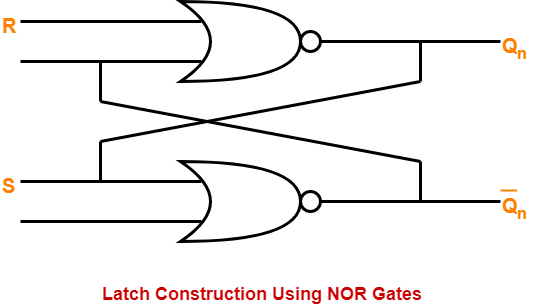Flip Flops-
Before you go through this article, make sure that you have gone through the previous article on Flip Flops.
We have discussed-
- A Flip Flop is a memory element that is capable of storing one bit of information.
- It is also called as Bistable Multivibrator since it has two stable states either 0 or 1.
There are following 4 basic types of flip flops-

- SR Flip Flop
- JK Flip Flop
- D Flip Flop
- T Flip Flop
In this article, we will discuss about SR Flip Flop.
SR Flip Flop-
- SR flip flop is the simplest type of flip flops.
- It stands for Set Reset flip flop.
- It is a clocked flip flop.
Construction of SR Flip Flop-
There are following two methods for constructing a SR flip flop-

- By using NOR latch
- By using NAND latch
1. Construction of SR Flip Flop By Using NOR Latch-
This method of constructing SR Flip Flop uses-
- NOR latch
- Two AND gates
Logic Circuit-
The logic circuit for SR Flip Flop constructed using NOR latch is as shown below-

2. Construction of SR Flip Flop By Using NAND Latch-
This method of constructing SR Flip Flop uses-
- NAND latch
- Two NAND gates
Logic Circuit-
The logic circuit for SR Flip Flop constructed using NAND latch is as shown below-

Logic Symbol-
The logic symbol for SR Flip Flop is as shown below-

Truth Table-
The truth table for SR Flip Flop is as shown below-
| INPUTS | OUTPUTS | ||
| S | R | Qn
(Present State) |
Qn+1
(Next State) |
| 0 | 0 | 0 | 0 |
| 0 | 0 | 1 | 1 |
| 0 | 1 | 0 | 0 |
| 0 | 1 | 1 | 0 |
| 1 | 0 | 0 | 1 |
| 1 | 0 | 1 | 1 |
| 1 | 1 | 0 | Indeterminate |
| 1 | 1 | 1 | Indeterminate |
Truth Table
The above truth table may be reduced as-
| INPUTS | OUTPUTS | REMARKS | ||
| S | R | Qn
(Present State) |
Qn+1
(Next State) |
States and Conditions |
| 0 | 0 | X | Qn | Hold State condition S = R = 0 |
| 0 | 1 | X | 0 | Reset state condition S = 0 , R = 1 |
| 1 | 0 | X | 1 | Set state condition S = 1 , R = 0 |
| 1 | 1 | X | Indeterminate | Indeterminate state condition S = R = 1 |
Truth Table
Characteristic Equation-
Draw a k map using the above truth table-

From here-
Qn+1 = ( SR + SR’ ) ( Qn + Q’n ) + Qn ( S’R’ + SR’ )
| Qn+1 = S + QnR’ |
Excitation Table-
The excitation table of any flip flop is drawn using its truth table.
|
What is excitation table? For a given combination of present state Qn and next state Qn+1, excitation table tell the inputs required. |
| Qn | Qn+1 | S | R |
| 0 | 0 | 0 | X |
| 0 | 1 | 1 | 0 |
| 1 | 0 | 0 | 1 |
| 1 | 1 | X | 0 |
Excitation Table
To gain better understanding about SR Flip Flop,
Next Article- JK Flip Flop
Get more notes and other study material of Digital Design.
Watch video lectures by visiting our YouTube channel LearnVidFun.





